

![]()
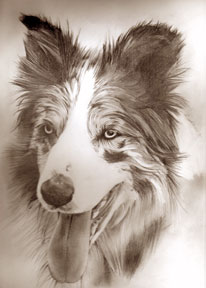
Above, a portrait of Teal,
by Scottish illustrator, Paul Adams, of Glenrothes, Fife.
MERLE BORDER COLLIES
[Please read our policy on accepting photos of dogs]
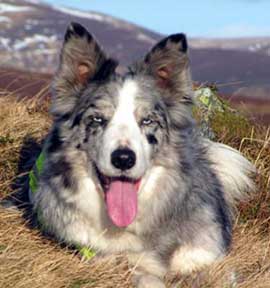 Left is blue merle Teal, belonging to Bob Adams of Kircaldy, Fife, Scotland. Bob is a hill walker, and Teal is his walking companion. Paul Adams, the illustrator of Teal, above, is Bob Adams son.
Left is blue merle Teal, belonging to Bob Adams of Kircaldy, Fife, Scotland. Bob is a hill walker, and Teal is his walking companion. Paul Adams, the illustrator of Teal, above, is Bob Adams son.
Merle is more a pattern than a color. It can affect any base color, so you can have blue merle (on base black), red merle (on base red), sable merle (on whatever base the sable is affecting), slate merle (on base blue), etc. Therefore, we have chosen to present one page with all the possible merles for which we currently have examples.
Without going too deeply into the genetics of merle (which can be found at en.wikipedia.org/wiki/Merle_(dog_coat)), let me just paraphrase Wikipedia by saying that if two merle dogs are mated, on average one quarter of the pups will be double merles (MM), and a high percentage of these double merle pups could have eye defects and/or be deaf. If no problems have shown up, the breeders have been lucky. Or they have been culling defective pups. Pier Vittorio Molinario, in his treatise "Il cane pastore della Valchiusella" (the Valchiusella Sheepdog)www.valchiusella.org/flora-e-fauna/il-cane-pastore-della-valchiusella) calls the M gene the "bleach gene". It is an apt descriptor. Double merle can cause excessive white, and, particularly when the white is on the head, and more specifically, on and in the ears, that is when hearing and sight defects may occur.
According to Molinario, it was recently noticed that the MM or the double merle gene pair does not produce the same effect in all breeds. Molinario posits that some groups of genes may be able to buffer or displace the MM pairs. In the Valchiusella, for example, the Australian red (ee) gene seems to provide that buffer. This might explain why some breeders, like Cane di Oropa (Oropa Sheepdog) breeders, or the Australian Koolie breeders, can be breeding double merles with impunity.
But why, Molinario asks, if the M gene is so risky, has natural selection or the supposed wisdom of the shepherds failed to eliminate it? It has, he says, become the hallmark of many groups of herding breeds. Molinario wonders if the M gene has something to do with herding acumen. He believes that it may make a dog more attentive to motion in the flock. I'd like to see a study done before I am convinced.
An article appeared on Wednesday, March 8, 2006 on the AKC Canine Health Foundation website that the merle patterning gene has been identified by the laboratory of Dr. Keith Murphy, Professor, Department of Pathobiology at the College of Veterinary Medicine and Biomedical Sciences of Texas A&M University. If this interests you, please click on the link above for the full article.
BLUE MERLES
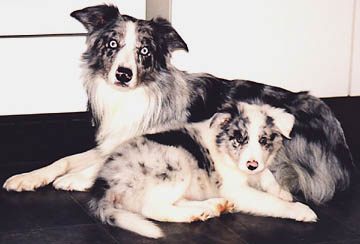 Left, look at this handsome father and son. They are Skye (the dad) and Blue, both belonging to Bob Lund of Glenrothes, Fife, Scotland. Skye is the son of Teal, above. He is now (2004) 4 years old, but was about 2 1/2 years old in the photo, and Blue was about 4
months.
Left, look at this handsome father and son. They are Skye (the dad) and Blue, both belonging to Bob Lund of Glenrothes, Fife, Scotland. Skye is the son of Teal, above. He is now (2004) 4 years old, but was about 2 1/2 years old in the photo, and Blue was about 4
months.
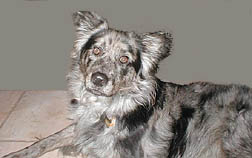 Left, Juli Mangham rescued Blake and says that she's been told many times that he is an Australian Shepherd mix, but she thinks is a Border Collie (he does have a tail, but he holds it curled over his back much of the time). Interestingly enough, Blake does not seen to have any white patches, but we think that his white collie markings are hidden by very heavy speckling. Merle affects only the black, but speckling, which is often mistaken for merling, affects the white, and a dog can have both merling and speckling.
Left, Juli Mangham rescued Blake and says that she's been told many times that he is an Australian Shepherd mix, but she thinks is a Border Collie (he does have a tail, but he holds it curled over his back much of the time). Interestingly enough, Blake does not seen to have any white patches, but we think that his white collie markings are hidden by very heavy speckling. Merle affects only the black, but speckling, which is often mistaken for merling, affects the white, and a dog can have both merling and speckling.
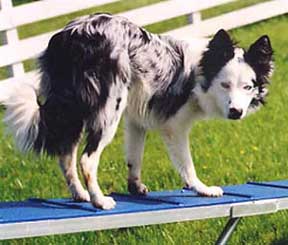 Left, this incredible-looking Border Collie is Diane Aramian's Magic ("Timeless Up My Sleeve"). Diane lives in Keswick, Virginia, and trains in agility with Paulena Renee Hope. She says that Magic's relatives, his grandfather "Fire", his dad "Stalker", and his aunt
"Never", are on this site. They are all red merles. Magic's mother is black and white.
Left, this incredible-looking Border Collie is Diane Aramian's Magic ("Timeless Up My Sleeve"). Diane lives in Keswick, Virginia, and trains in agility with Paulena Renee Hope. She says that Magic's relatives, his grandfather "Fire", his dad "Stalker", and his aunt
"Never", are on this site. They are all red merles. Magic's mother is black and white.
![]() Is it just me, or does this girl (left) have "bedroom eyes"? She is "Sprite", belonging to Jan Laidlaw from Nanaimo, British Columbia, Canada. Jan adopted Sprite from Border Collie Rescue in Vancouver. Like Kyp, above, Sprite has a lot of black on her, raising the question as to why the merle gene only affects some of the black on some dogs, and not all of it; whereas on other dogs, all of the black seems to be broken up by the merling. Anyone have a guess?
Is it just me, or does this girl (left) have "bedroom eyes"? She is "Sprite", belonging to Jan Laidlaw from Nanaimo, British Columbia, Canada. Jan adopted Sprite from Border Collie Rescue in Vancouver. Like Kyp, above, Sprite has a lot of black on her, raising the question as to why the merle gene only affects some of the black on some dogs, and not all of it; whereas on other dogs, all of the black seems to be broken up by the merling. Anyone have a guess?
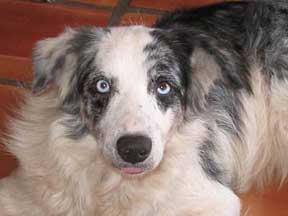 Right, is Kipper who belongs to Figueroa of Fort Lauderdale, Florida. We had to include her photo because she demonstrates the "merle eye". Her left eye is part blue and part brown. As you can see, every merle dog does not have "merle eyes", nor is the "merle eye" limited to merle dogs. Kipper competes in flyball.
Right, is Kipper who belongs to Figueroa of Fort Lauderdale, Florida. We had to include her photo because she demonstrates the "merle eye". Her left eye is part blue and part brown. As you can see, every merle dog does not have "merle eyes", nor is the "merle eye" limited to merle dogs. Kipper competes in flyball.
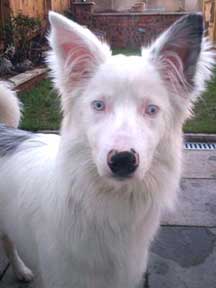 Left, Zack is a blue merle with a preponderance of white, and I associate his look with double merle breeding and possible deafness. But Zack's owner, Pete Firth of Manchester, England, says he is not deaf. Zack is a rescue dog.
Left, Zack is a blue merle with a preponderance of white, and I associate his look with double merle breeding and possible deafness. But Zack's owner, Pete Firth of Manchester, England, says he is not deaf. Zack is a rescue dog.
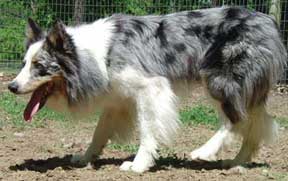 Beautiful blue merle tri Sage (left) belongs to Tracy Heinlein.
Beautiful blue merle tri Sage (left) belongs to Tracy Heinlein.

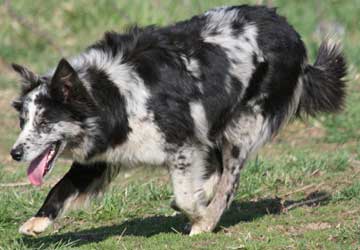 Left is Mac, bred by Wendy Frevert of Plum Ridge Training Centre in Williamsport, Indiana. Mac is the father of Rain, right, and her littermate, Fog, a slate merle appearing below. Both Mac and Rain are very interestingly marked blue merles, with large black patches which make them look almost like heavily ticked pattern whites. But closer observation shows that the "ticking" is in a grey ground.
Left is Mac, bred by Wendy Frevert of Plum Ridge Training Centre in Williamsport, Indiana. Mac is the father of Rain, right, and her littermate, Fog, a slate merle appearing below. Both Mac and Rain are very interestingly marked blue merles, with large black patches which make them look almost like heavily ticked pattern whites. But closer observation shows that the "ticking" is in a grey ground.
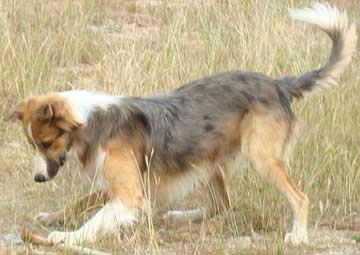
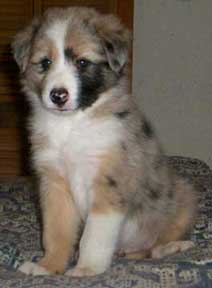 This is Concho who belongs to Tamara Minter of West Texas. At first I thought Concho might be a saddle-pattern blue merle, but the photo of him as a puppy indicates that he has the same amount of tan as he did when he was young, so he is just an extreme tricolor.
This is Concho who belongs to Tamara Minter of West Texas. At first I thought Concho might be a saddle-pattern blue merle, but the photo of him as a puppy indicates that he has the same amount of tan as he did when he was young, so he is just an extreme tricolor.
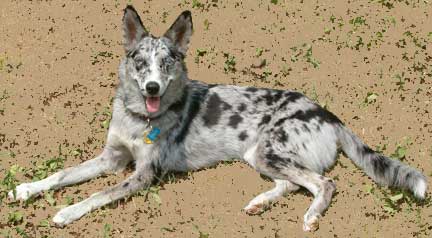 Merles of course can come in smooth-coat as well as rough-coat, and Echo, left, is an example of a smooth-coated blue merle. She belongs to Melissa Preston-Fleming of West Virginia.
Merles of course can come in smooth-coat as well as rough-coat, and Echo, left, is an example of a smooth-coated blue merle. She belongs to Melissa Preston-Fleming of West Virginia.
SLATE MERLE
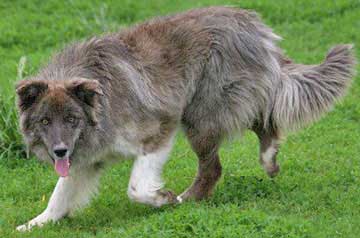 Slate merle is merle on a blue base. Since the term "blue merle" was already taken for merle on a black base, slate merle is what they called it. We have just one example of slate merle and hope to get a few more, because it is hard to tell that Fog, left, is a merle. Fog is the littermate of Rain and son of Mac, above. Given the tan on his head, body, and legs, one might think he is a slate brindle, which also would be difficult to see. So we'll take his owner's word for it that he is merle, as she is an experienced breeder. Fog is amazing-looking, and I have to say, I've never seen a dog look more like a wolf before.
Slate merle is merle on a blue base. Since the term "blue merle" was already taken for merle on a black base, slate merle is what they called it. We have just one example of slate merle and hope to get a few more, because it is hard to tell that Fog, left, is a merle. Fog is the littermate of Rain and son of Mac, above. Given the tan on his head, body, and legs, one might think he is a slate brindle, which also would be difficult to see. So we'll take his owner's word for it that he is merle, as she is an experienced breeder. Fog is amazing-looking, and I have to say, I've never seen a dog look more like a wolf before.
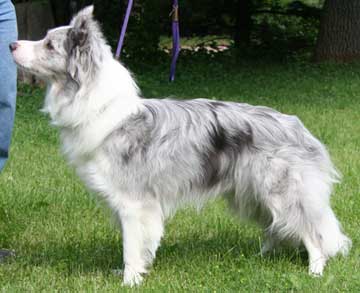 This is "Slate", left, a slate merle who belongs to Angie Boughton from Minnesota. It's easier to understand slate merle when looking at Slate. He looks just like a "regular" blue merle, except, where blue merles have black (particularly, the nose, and black patches), Slate has blue or dark grey. The lighter grey or dilution, is the same as on "ordinary" blue merles (though it may be paler, because blue is already a dilution).
This is "Slate", left, a slate merle who belongs to Angie Boughton from Minnesota. It's easier to understand slate merle when looking at Slate. He looks just like a "regular" blue merle, except, where blue merles have black (particularly, the nose, and black patches), Slate has blue or dark grey. The lighter grey or dilution, is the same as on "ordinary" blue merles (though it may be paler, because blue is already a dilution).
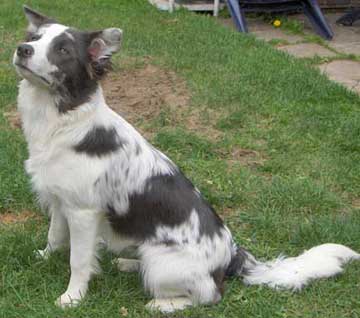 Another beautiful slate merle, Eirian, belonging to Nadine Verhoeven of Zelzate, Belgium.
Another beautiful slate merle, Eirian, belonging to Nadine Verhoeven of Zelzate, Belgium.
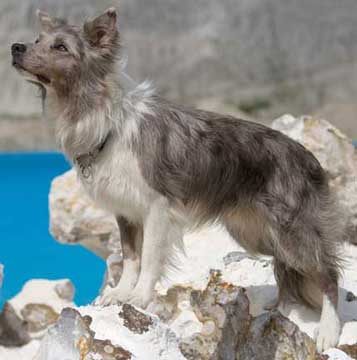
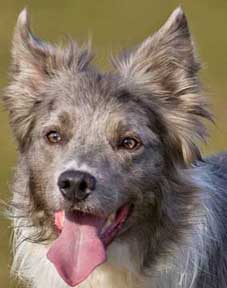 This is Zack, a slate merle belonging to Malene Nielsen of Denmark. At first, he might look like just a blue or slate dog, but his face reveals the merle markings.
This is Zack, a slate merle belonging to Malene Nielsen of Denmark. At first, he might look like just a blue or slate dog, but his face reveals the merle markings.
RED MERLES
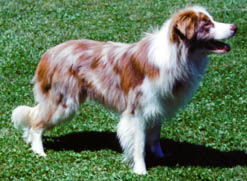 Left, this gorgeous red merle Border Collie is appropriately called Fire. He belongs to Dawn Sandberg from Rockford, Illinois.
Left, this gorgeous red merle Border Collie is appropriately called Fire. He belongs to Dawn Sandberg from Rockford, Illinois.
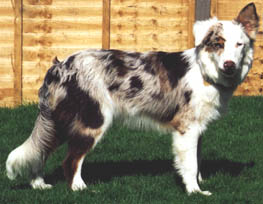 This handsome boy with ice-blue eyes and mismatched ears, is Matisse (Detania Shmily Matisse) who was shown at just over 6 months old. Matisse belongs to Paula Wright, of Haverhill, Suffolk, England. His dam is Detania Heatherbelle, and his sire is Detania Delinwood. Paula says that he is a "cheeky chappie" and that he and his sibling are permanantly trying to round her up on walks. She thinks that he is unconventional-looking and therefore not out of place on this page--what could she mean by that? Perhaps by show standards--but Matisse and the others only prove how diverse the Border Collie gene pool is when it comes to looks.
This handsome boy with ice-blue eyes and mismatched ears, is Matisse (Detania Shmily Matisse) who was shown at just over 6 months old. Matisse belongs to Paula Wright, of Haverhill, Suffolk, England. His dam is Detania Heatherbelle, and his sire is Detania Delinwood. Paula says that he is a "cheeky chappie" and that he and his sibling are permanantly trying to round her up on walks. She thinks that he is unconventional-looking and therefore not out of place on this page--what could she mean by that? Perhaps by show standards--but Matisse and the others only prove how diverse the Border Collie gene pool is when it comes to looks.
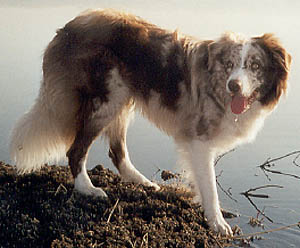 Another superb example of a red merle is Aki, right, a 1 1/2 year old Border Collie who belongs to Nathalie Goovaerts of Belgium.
Another superb example of a red merle is Aki, right, a 1 1/2 year old Border Collie who belongs to Nathalie Goovaerts of Belgium.
 This lovely creature (left) is 6 year old Katie, who belongs to Andrea Russ from Portsmouth, England. Of Katie, Andres says: "Kate competes at senior level in agility and considering her handicap (me) does quiet well, but more importantly she is a wonderful pet and very much loved."
This lovely creature (left) is 6 year old Katie, who belongs to Andrea Russ from Portsmouth, England. Of Katie, Andres says: "Kate competes at senior level in agility and considering her handicap (me) does quiet well, but more importantly she is a wonderful pet and very much loved."
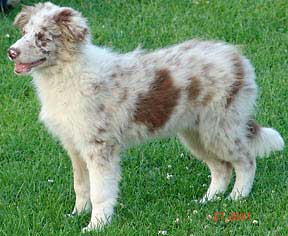
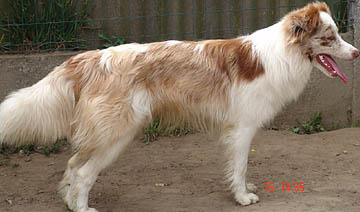 The red merle bitch puppy on the left is called Dakota Of Maranns Home and the red merle
male on the right is Falconmoor Merle Invasion, called Indy. Indy is an English import.
Both beautiful dogs live in Belgium with Marnix and Christel van den Steen, who own the
Border Collie kennel Of Maranns Home.
The red merle bitch puppy on the left is called Dakota Of Maranns Home and the red merle
male on the right is Falconmoor Merle Invasion, called Indy. Indy is an English import.
Both beautiful dogs live in Belgium with Marnix and Christel van den Steen, who own the
Border Collie kennel Of Maranns Home.
Ruby, left, a split-faced, red merle female with one blue eye, belongs to Phyllis Cardoza of Chatsworth, California. Ruby turned 12 years old in December of 2004,
and the photo was taken the previous January.
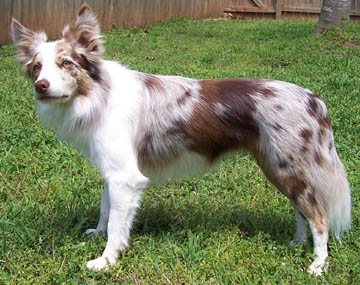 Right is Siryn, a beautiful and interestingly marked red merle female belonging to
Donna Wasielewski of Austin, Texas. Of Siryn, Donna says: "Her mother was a black and
white and her father was a blue merle. There was no red for 7 generations in the pedigree
to the point where nobody even knew that they carried the red genes. The litter was born
with 1 red and white, 1 red tri, 2 red merles, 1 blue merle, and 1 black and white. You
can imagine the breederšs surprise since she was expecting all black and whites and
blue merles!
Right is Siryn, a beautiful and interestingly marked red merle female belonging to
Donna Wasielewski of Austin, Texas. Of Siryn, Donna says: "Her mother was a black and
white and her father was a blue merle. There was no red for 7 generations in the pedigree
to the point where nobody even knew that they carried the red genes. The litter was born
with 1 red and white, 1 red tri, 2 red merles, 1 blue merle, and 1 black and white. You
can imagine the breederšs surprise since she was expecting all black and whites and
blue merles!
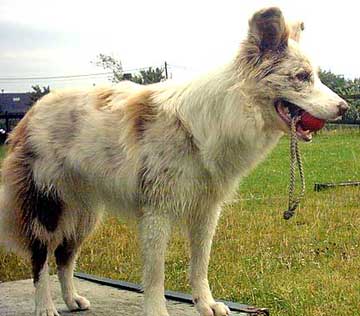
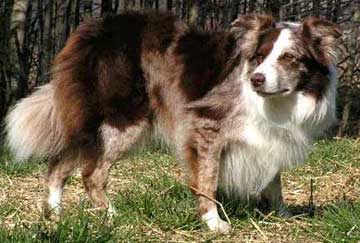
These two red merles are very interestingly marked, so I thought I'd share their photos with you. They are, far left, Quenya belonging to Bonnie Van Garsse from Belgium, left, Fall belonging to Denise Morris of Scottsburg Indiana.
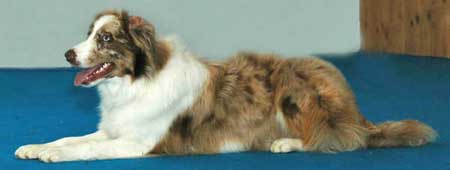 And this one is interestingly colored with several shades of red. He is Flynn and was bred by Diny Damen of Oosterhout, The Netherlands.
And this one is interestingly colored with several shades of red. He is Flynn and was bred by Diny Damen of Oosterhout, The Netherlands.
SABLE MERLE
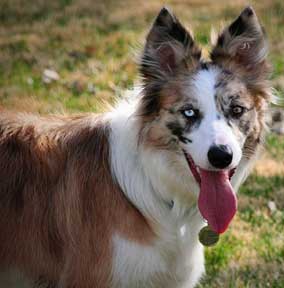
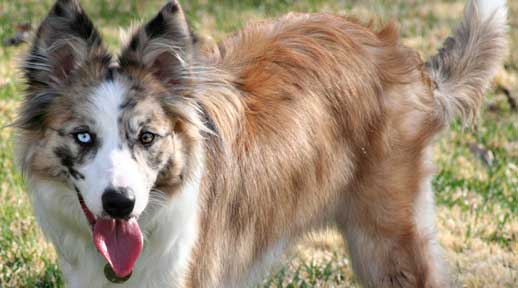
This is Reba, who belongs to Sarah LeBlanc of St. Louis, Missouri. Reba is a gorgeous sable merle. Sarah's mother, Lori LeBlanc sent in her photos.
OTHER TYPES OF MERLES
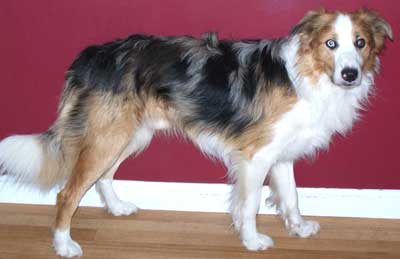
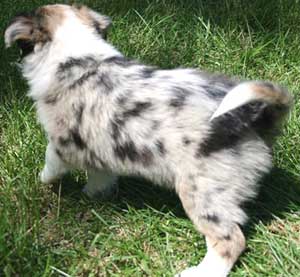 Just when you think you've seen the ultimate color pattern, a dog like Ranger ("Quantum Leap's Blue Ranger"), left, comes along! Ranger is a saddle-patterned blue merle with one blue eye and one "merle eye" (part blue, part brown). He belongs to Gina Cavacas of Wareham, Massachusetts. He's her first Border Collie and he will be a hard act to follow.
Right, Ranger as a puppy. Notice how much more wide-spread the merle pattern was when he was young. Just like black recedes to a saddle in more usual saddle-patterned dogs, in Ranger the merle receded to form the saddle.
Just when you think you've seen the ultimate color pattern, a dog like Ranger ("Quantum Leap's Blue Ranger"), left, comes along! Ranger is a saddle-patterned blue merle with one blue eye and one "merle eye" (part blue, part brown). He belongs to Gina Cavacas of Wareham, Massachusetts. He's her first Border Collie and he will be a hard act to follow.
Right, Ranger as a puppy. Notice how much more wide-spread the merle pattern was when he was young. Just like black recedes to a saddle in more usual saddle-patterned dogs, in Ranger the merle receded to form the saddle.
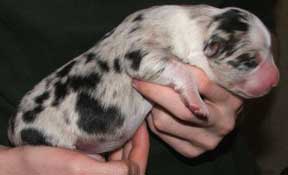
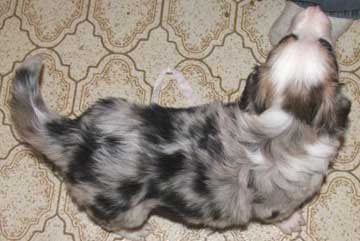
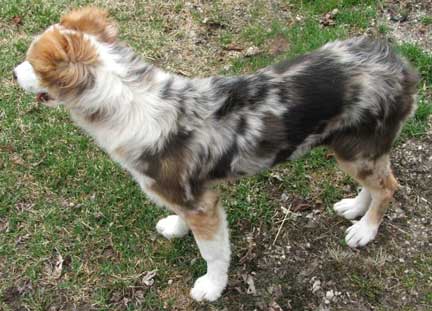
Here's one I need your help on. The above three pictures are of iWren, belonging to Patty Ko. Her dam, Tally, is a blue merle, and her sire, Reese, is a saddle-patterned dog. I believe she is a saddle merle, but she seems to have both black and slate spots. Can anyone solve this problem for me?
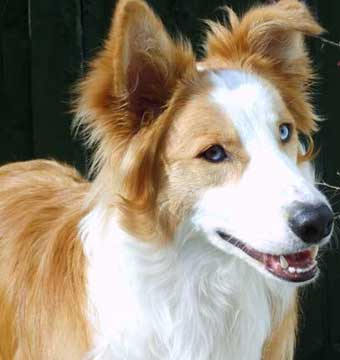
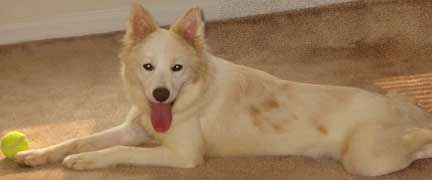 These two dogs, Buddy on the left and Lacy on the right, are both tan merle (or merle on a recessive yellow base). Buddy belongs to Donna Mar and Lacy belongs to Allyson Keyser.
These two dogs, Buddy on the left and Lacy on the right, are both tan merle (or merle on a recessive yellow base). Buddy belongs to Donna Mar and Lacy belongs to Allyson Keyser.
HARLEQUIN MERLE BORDER COLLIES
A researcher at Clemson University in South Carolina, Leigh Ann Clark, is researching what modification causes harlequins instead of "ordinary" merles. She's looking at [Great] Danes (where harlequin occurs frequently), but is also interested in other breeds in which harlequin may occur. These would be breeds where merle occurs. What she is looking for are merles, where the dilute patches are very pale (white or nearly white).
Dr. Phil Sponenberg, a veterinarian, a professor of pathology and genetics at the Virginia-Maryland Regional College of Veterinary Medicine in Blacksburg, Virginia, and a color genetics expert is assisting her in locating harlequins in other breeds, and he contacted me. A friend of his, Mike Vaughan, a doctor of molecular biology, is also assisting Leigh Ann Clark with this study. He became interested in it when one of his Smooth Collies produced a harlequin pup.
He explains the color mechanism more thoroughly:
Basically a Harlequin is a dog born to one merle parent (genotype Mm or MM) and one non-merle parent (genotype mm) that has a white body coat color at birth, with either black/gray or brown spots on the body and head/tail. In other words the dilution of the body coat color in a Harlequin is complete, unlike a regular merle. The merle parent can be either a blue merle or, in Collie terminology, a sable merle. The puppy may have tan spots, like a tricolor, on legs and face. Almost all Collie Harlequins have a tricolor parent and thus have black/gray spots...A very few Collie Harlequins, with a sable merle parent, have brown spots...
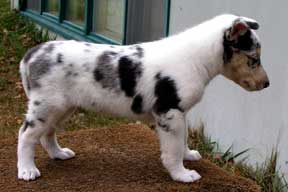 The bottom line is, if you have a harlequin dog/pup, or have seen one in your
litters, please contact me at shepdog@gis.net and I will convey this information to Mike. Leigh Ann
will then ask you or the owner of the dog if they are willing to donate a blood
sample from the dog to her research project. She will cover the cost of a vet
taking the sample and shipping it to her at Clemson.
The bottom line is, if you have a harlequin dog/pup, or have seen one in your
litters, please contact me at shepdog@gis.net and I will convey this information to Mike. Leigh Ann
will then ask you or the owner of the dog if they are willing to donate a blood
sample from the dog to her research project. She will cover the cost of a vet
taking the sample and shipping it to her at Clemson.
Until we have some pictures of harlequin Border Collies, at left is a photo of Mike Vaughan's harlequin Smooth Collie puppy.
[Please click on the pictures to get to a page.]
 BLACK-AND-WHITE |
 BLUE |
 BRINDLE |
 LILAC |
 MERLE |
 PATTERNED WHITE & COLOR-HEADED WHITE |
 RED (CHOCOLATE /BROWN) |
 SABLE |
 SADDLE PATTERNED |
 SPLIT FACE (HALF-WHITE FACE) & ALL-WHITE FACE |
 TAN (AUSTRALIAN RED) |
 TICKED |
 TRICOLOR & BLACK-AND-TAN |
 COAT TYPE |
 EYE COLOR |
 EARS |
 FOCUS |
THE OTHER WEB PAGES WE MAINTAIN
These web pages are copyright ©2013
and maintained by webmeistress Carole Presberg
with technical help from webwizard David Presberg
ALL RIGHTS RESERVED
If you are interested in using ANY material on this website, you MUST first ask for permission.